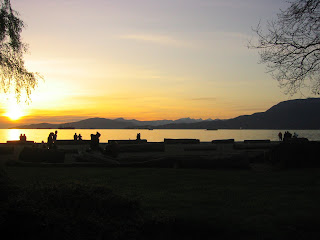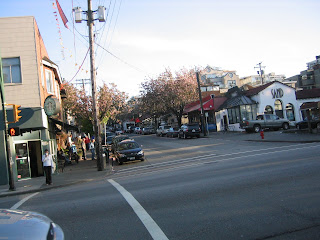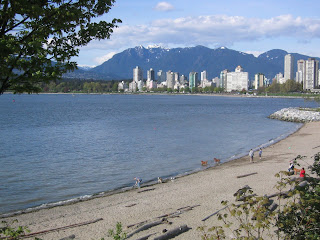There are a
lot of similar-sounding geographical names around Greater Vancouver.
There's Downtown, the Downtown Eastside, the West Side, the West End, New West, West Van, East Van, North Van, and so on.
Confused?
You're probably not alone.
Locals take for granted what places these names refer to, but I'm sure it causes some initial confusion for others as it's not necessarily logical nor are these places always represented on maps.
To make sure everyone's on the same page, I wanted to write an intro Vancouver geography lesson. These are
my personal definitions and not necessarily the
official definitions, but close enough for these purposes.
Note that I am not going over every Vancouver neighbourhood, but only those which may cause confusion.
To begin, the City of Vancouver, simply called
Vancouver, is shaped a bit like an oven mitt.
 Vancouver
VancouverVancouver's city centre, often just called Downtown, is located on a tiny peninsula on the "thumb" of that oven mitt.
 the Downtown peninsula
the Downtown peninsulaOften when I talk about Downtown, I am usually talking about that entire peninsula. On that peninsula are a variety of distinct neighbourhoods such as Gastown, Coal Harbour, the Downtown core, Yaletown, and the West End. When I talk about the Downtown peninsula, I am lumping all these areas together. This is not an official name by the way, but it tends to make sense.
Other times you'll hear people talking about Downtown, but they might be referring to the Downtown
core.
 the Downtown Core
the Downtown CoreThe Downtown core is a much tinier area of the Downtown peninsula. It typically refers to the office towers and businesses along Granville, Seymour, Richards, Howe, Hornby, and Burrard. This is not an official definition by any means, and in all reality, these boundaries are very fluid. So you never know when people are talking about "Downtown" - are they referring to the Downtown peninsula or its business core? It helps to clarify.
Just west of the Downtown core is the West End.
 the West End
the West EndThis is the south-western corner of the Downtown peninsula, west of Burrard Street and south of Robson Street. It's a high density residential neighbourhood with a diverse demographic and loads of character. It's next to Stanley Park and is bordered by beaches and the seawall. The two main commercial strips in the West End are located along Davie Street and Denman Street. The West End is also home to Davie Village, the heart of Vancouver's gay community.
Then there's the Downtown Eastside.
 the Downtown Eastside
the Downtown EastsideThe Downtown Eastside is located in the extreme north-east of the Downtown peninsula, sort of a geographical
no man's land between Chinatown and Gastown. It's a neighbourhood that most well-meaning individuals like to warn tourists about.
The Downtown Eastside is in all reality a very small small part of the city located along Hastings, east of Cambie and west of Clark. Technically Gastown and Chinatown are a part of the Downtown Eastside, although when most people refer to the neighbourhood, they're often only thinking about the seedy areas. Although it's the oldest neighbourhood in Vancouver, the drug addicts, prostitutes, homeless, and filthy alleys around Main & Hastings are what people imagine when they think of the Downtown Eastside. Contrary to popular belief, it's not really a dangerous area, although looks would suggest otherwise.
Then there's East Vancouver, often just called
East Van.
 East Van
East VanEast Van is the entire eastern half of the City of Vancouver and is home to a variety of distinct and vibrant neighbourhoods such as Commercial Drive, Mount Pleasant, Strathcona, Punjabi Market, and Hastings-Sunrise. East Van has traditionally been the more affordable half of Vancouver with a demographic to match. It's the underdog with strong community spirit and it's home to Vancouver's artsy, bohemian edge.
Ontario Street is technically where the city divides itself between and east and west, but since Ontario's a minor street, most people will tell you that Main Street (2 blocks over) is the dividing point. The easiest way to tell if you're in East Van is to look at the street signs as they'll have East in their names: E 8th Ave, E Hastings, E Georgia, etc.
So if the eastern half of Vancouver is East Van, you'd logically assume that the western half would be called West Van... but this is not the case. The western half of Vancouver is called the West
Side.
 the West Side
the West SideIt's called the West Side, and not West Vancouver, because there is a satellite city across the bridge from Vancouver and its name is West Vancouver. And we can't call the West Side "the West End" because of the West End neighbourhood on the Downtown peninsula.
Confused yet?
The West Side refers to anywhere in Vancouver that's west of Ontario Street. The West Side usually doesn't include the Downtown peninsula. The street signs will have "West" in their names: W 4th Ave, W 49th Ave, W Broadway, etc. The West Side is definitely the more affluent half of the city, again with a demographic to match. The feeling is more gentrified, yuppified, and less grassroots than East Van, but it's also where you'll find the scenic vistas that Vancouver's so famous for.
The West Side isn't a term you'll hear locals using often. You might read the term in a real estate listing, or you might hear it being used in general comparison to East Van. Most people, if they're referring to the West Side, will be more specific and will use the name of the neighbourhoods within the West Side, such as Kitsilano, Marpole, Point Grey, Southlands, Dunbar, Kerrisdale, Shaughnessy, South Granville, etc. You'll rarely hear, "I live in the West Side", but rather, "I live in Kitsilano".
* * *
I now want to focus outside of Vancouver to the satellite cities that make up "Greater Vancouver" or "Metro Vancouver". Although these satellite cities are more than just bedroom communities and often have their own distinct histories and identities, locals refer to them as "the suburbs" even if some of them are older than Vancouver itself!
Some of Vancouver's most popular tourist attractions, like the Capilano Suspension Bridge, Grouse Mountain, and Lynn Canyon, are actually located in
North Vancouver. North Vancouver, often shortened to
North Van, is a separate city from Vancouver. It has its own mayor, its own school board, its own municipal services, library system, etc. which are distinct from Vancouver.
 North Van
North VanNorth Van is located to the north-east of Vancouver on the other side of Burrard Inlet at the base of two mountains: Grouse and Seymour. The Lion's Gate Bridge and the Iron Worker's Memorial Bridge (previously the Second Narrow's Bridge) connect Vancouver to North Van. Statistically, North Van is the rainiest city in Greater Vancouver.
To the west of North Vancouver is a city called West Vancouver, or
West Van.
 West Van
West VanWest Van is possibly the most affluent city in the province, full of multi-million dollar mountainside mansions with swimming pools, tennis courts, and panoramic views. It's also home to Cypress Mountain and the Horseshoe Bay ferry terminal. Most people pass through West Van on their way from Vancouver to Whistler.
Together North Vancouver and West Vancouver form the "North Shore" - the north shore of the Burrard Inlet.
 the North Shore
the North ShoreFrom the map you can see that Burrard Inlet is the body of water that separates the North Shore from Vancouver.
The only other city that may cause initial confusion is New West. New West is short for the City of New Westminster. Note that there is only
one letter
i in New Westm
inster.
 New West
New WestNew West is located south-east of Vancouver. It takes about 30 minutes by Skytrain to travel to New West from Downtown.
While locals think of New West as a suburb, it was one time the capital city of
British Columbia, between 1860-1868, back when Vancouver Island and British Columbia were two separate British colonies. Since New Westminster was founded in 1859, that makes it one of those "suburbs" with a longer history than Vancouver. Of course, it's all relative. Vancouver was founded in the 1870's and only became a city in 1886.


 Click photo to zoom in
Click photo to zoom in



ed.jpg)


























